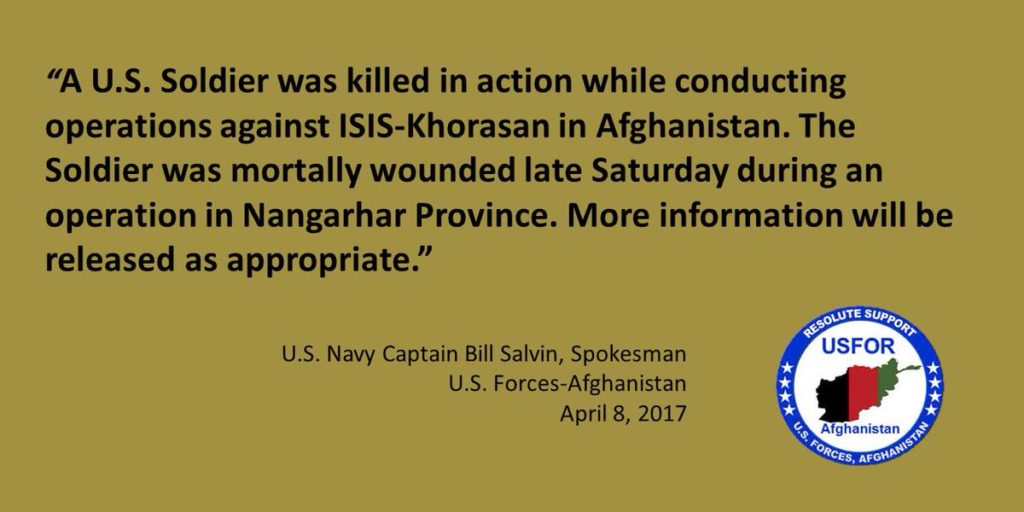
An American soldier was killed while fighting the Islamic State’s arm in Afghanistan earlier today, according to US officials.
“A US Soldier was killed in action while conducting operations against ISIS-Khorasan in Afghanistan,” Navy Captain Bill Salvin, the spokesman for US Forces – Afghanistan, said in a statement released on Twitter. “The Soldier was mortally wounded late Saturday during an operation in Nangarhar Province. More information will be released as appropriate.”
Salvin later told Reuters that the American was a Special Forces operator.
Nangarhar, an eastern Afghan province, is the main hub for the Islamic State’s operations in the region.
Just hours before the US military’s announcement, the Islamic State released a statement claiming that four Afghan soldiers had been killed and a “Crusader American soldier” wounded. The jihadists said they initiated the raid against their enemies.
“By Allah’s grace, a group of inghimasi fighters attacked a position of the…Afghani army in the area of Shadel Achin in Nangarhar,” the Islamic State’s message reads. “They engaged with them using their light weapons, which resulted in the killing of four [Afghan soldiers] and the injury of a Crusader American soldier with serious wounds, and all praise is due to Allah.”
Inghimasi fighters are highly-trained jihadists who immerse themselves in the fight and are prepared to commit suicide bombings, if necessary.
Abu Muhammad al Adnani, the Islamic State’s first spokesman, announced his organization’s expansion into Afghanistan and Pakistan in Jan. 2015. The Islamic State’s Khorasan branch, known as Wilayah Khorasan (or Khorasan province), was headed by Hafiz Saeed Khan, a former commander in the Pakistani Taliban (Tehrik-e Taliban, or TTP) who announced his allegiance to Abu Bakr al Baghdadi in late 2014. Khan was killed in a US airstrike in July 2016.
Khan was not the only significant Wilayah Khorasan figure killed or captured in 2016. The US military has repeatedly targeted Baghdadi’s loyalists in Afghanistan.
According to General John W. Nicholson Jr., the commander of NATO’s Resolute Support and US Forces Afghanistan, 12 Wilayah Khorasan leaders (including Khan) were killed in 2016. Nicholson added that the caliphate’s Afghan branch incurred “roughly” 500 casualties in total, which is an estimated “25 to 30 percent” of the organization’s overall force.
Therefore, based on the US military’s figures, Wilayah Khorasan had between 1,600 and 2,000 total fighters before suffering from attrition last year.
The US-led counterterrorism campaign also destroyed about “two dozen command and control facilities,” as well as “training facilities,” according to Nicholson. In addition, the Wilayah Khorasan’s “sanctuary” was reduced from “nine districts in Afghanistan…down to three.”
However, the Islamic State still has a lethal network inside the country. And while the so-called caliphate’s men don’t contest or control nearly the same amount of territory as the al Qaeda-allied Taliban, they can still carry out significant attacks.
In March, for instance, a suicide assault team raided the Sardar Mohammad Daud Khan Hospital in Kabul. The hospital is Afghanistan’s largest military medical establishment. Dozens of people were killed or wounded in the terrorist operation, which was quickly claimed by the Islamic State. [See FDD’s Long War Journal report, Islamic State suicide team assaults military hospital in Kabul.]
In a separate tweet today, Resolute Support said the hospital was being renovated “with upgraded medical equipment” and “enhanced security.”
Wilayah Khorasan claims to have killed other Afghan soldiers in recent days, including in mortar attacks in Nangarhar.
FDD’s Long War Journal assessed early on that Wilayah Khorasan incorporated disaffected commanders from the Afghan and Pakistani Taliban, as well as Uzbek jihadists who defected from groups allied with the Taliban and al Qaeda.
This was subsequently confirmed by US authorities. The State Department designated Wilayah Khorasan in Sept. 2015, noting that it “consists of former Pakistani and Afghan Taliban faction commanders.”
And in December, Gen. Nicholson explained that various jihadist “groups mix and converge.” Nicholson added that Wilayah Khorasan “is formed of members of the Tehrik-e Taliban Pakistan, the Islamic Movement of Uzbekistan and even some former members of the Afghan Taliban.”
However, the Pakistani Taliban was reconstituted, most of the Afghan Taliban remains loyal to its leadership, and pro-Islamic State Uzbek jihadists suffered significant losses in the rivalry that ensued with their counterparts in the Taliban-al Qaeda axis.








1 Comment
After eight years of silence, the media is going to start putting draped coffins on the screen again?